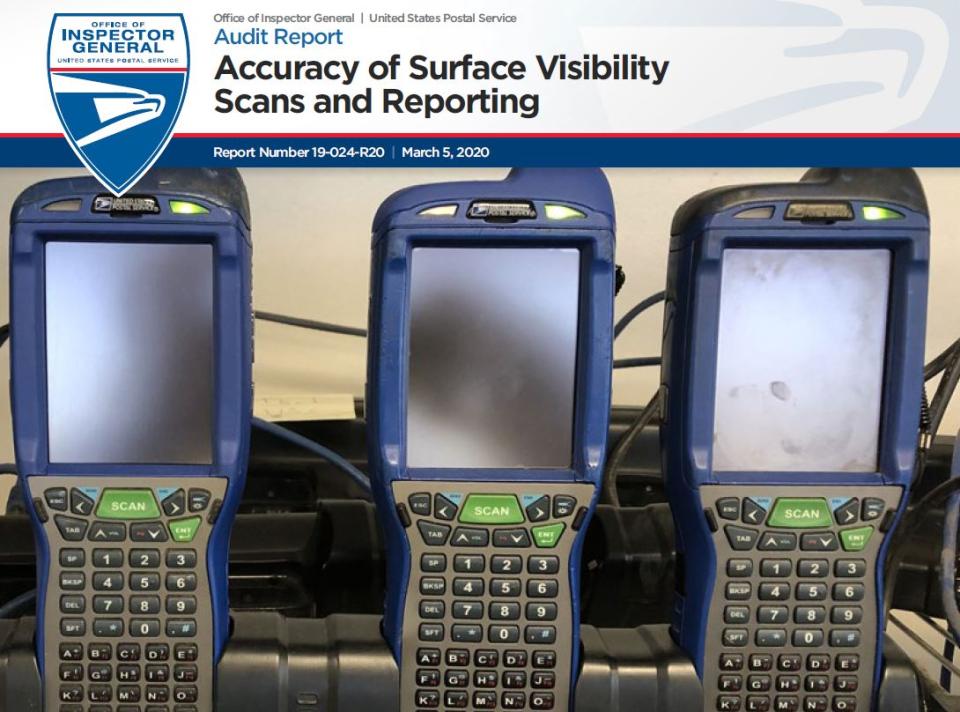Accuracy of Surface Visibility Scans and Reporting
Objective
The objective of our audit was to evaluate the accuracy of Surface Visibility scans and reporting for Highway Contract Route (HCR) and Postal Vehicle Service (PVS) trips. This audit was requested by the Postal Service’s Surface Logistics group.
The U.S. Postal Service’s surface transportation network is managed locally and transports mail and equipment to and from Postal Service facilities daily. Surface transportation includes HCR, PVS, maritime, and rail service contracts. The Postal Service uses HCRs to transport mail and other products between plants and other designated stops for distances generally over 50 miles. PVS operations are internally operated by the Postal Service and trips are generally within a 50-mile radius of Postal Service facilities.
Surface Visibility Web 2.0 (SVweb) provides the Postal Service with real-time data and reporting on the movement of HCR and PVS trucks in the surface transportation network. Expeditors at mail processing facilities are responsible for the on-time dispatching and routing of mail for transportation. Expeditors use handheld scanners to scan trailer barcodes which record trip arrival and departure times.
When trucks are late, expeditors select a delay reason code in the scanner (either a Postal Service or contractor delay reason) to provide visibility in SVweb that reflects why the trip was late. Contractors can be assessed penalties for late trips if they do not correct deficiencies after notification by the Postal Service.
In April 2019, headquarters and area management informed plant management that the goal was to have no late trips; therefore, all trips should depart and arrive to their destinations on-time. Plant management is accountable for late trips and required to explain why late trips occurred during daily meetings with area personnel. They must also prepare plan of action reports for the Chief Operating Officer to review in order to avoid late trips in the future. In addition, plant management’s performance is measured using metrics from the National Performance Assessment (NPA) including the Trips on Time indicator.
We visited six mail processing facilities in the Capital Metro, Great Lakes, Western, and Pacific Areas from October through November 2019. We observed the scanning of HCR and PVS trucks arriving and departing, as well as which late reason codes were used for late trips. We also interviewed plant management, supervisors, network specialists, and expeditors, and reviewed SVweb data.
Findings
The Postal Service is not accurately reporting HCR and PVS truck arrival and departure times. While personnel are properly scanning trip arrival and departure times, we found employees at the six mail processing facilities we visited were manually editing the arrival and departure scan times in SVweb to show trips as on-time when they were actually late. In fiscal year (FY) 2019, 80,795 (0.23 percent) of nearly 35 million trip scans were manually edited from late to on-time in SVweb.
We also found that certain mail processing facilities were moving away from manually editing arrival and departure times to editing scheduled trip times instead. Employees were editing PVS scheduled trip times at two of the six facilities we visited to later times so that trips appeared to be on-time when they were actually late. The Postal Service only began tracking edited scheduled trip times in August 2019. For example, at one mail processing facility we visited, local employees made 671 manual edits to arrival and departure times in August 2019, but only made 275 manual edits in September 2019 (a decrease of about 59 percent). However, local employees edited 3,074 scheduled trip times in August 2019 and 5,722 scheduled trip times in September 2019 (an increase of 86 percent).
This occurred because plant management requested that employees minimize late trips. By doing so, plant management could avoid explaining why late trips occurred during daily meetings with area personnel and preparing plan of action reports. This practice could also help plant management meet their NPA goal for the Trips on Time indicator. We referred this issue to the Office of Investigations for further review.
Additionally, there are inadequate controls over who can make manual edits in SVweb. SVweb allows users with certain system access to edit arrival, departure, and scheduled trip times. We identified managers, supervisors, specialists, expeditors, acting supervisors, and a vehicle clerk with access to make edits in SVweb. Further, there is no guidance on when it is appropriate to edit these times and SVweb does not require a manager’s approval or justification explaining why a manual edit was made.
Trips on Time is an important metric the transportation network uses to measure performance. Data integrity becomes an issue when trips and schedules are manually edited from late to on-time. Using inaccurate data to support management conclusions puts the Postal Service at risk of making operational decisions that are incorrect and can negatively affect the transportation network.
Recommendations
We recommended management:
- Issue supplemental guidance on manually editing arrival, departure, and scheduled trip times in SVweb.
- Determine whether manual edits to arrival, departure, and scheduled trip times in SVweb should be included when calculating the NPA goal for Trips on Time.
- Implement controls in SVweb to ensure only properly authorized personnel are making appropriate manual edits in Surface Visibility Web 2.0.

